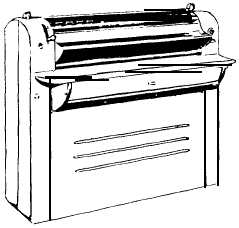Starting or stalling difficulties:
1. Voltage too low.
2. Machine not level, causing binding.
3. Wiring loosened or disconnected. Call
dealer.
Ammonia leakage:
1. Developer chamber top not properly
latched after inspection.
2. Ammonia drain tube locked.
3. Machine not level, preventing proper
drainage.
4. Ammonia bottle improperly capped.
5. Ruptured pump tubing.
Wrinkled prints from developer jamming:
1. Condensation in ammonia chest.
2. Did not use nite-sheet.
3. Sensitized paper damp before using,
because of humid storage.
4. Paper placed in developer chamber against
the grain.
5. Foreign material in developer chamber.
6. Exit not clear.
Lamps burn out prematurely:
1. Improper voltage.
2. Air entrance blocked causing hot lamps.
3. Improper or defective starters.
4. Shorting in wiring.
Prints do not develop:
1. Weak or exhausted ammonia—replace.
2. Sensitized paper old or exposed.
3. Ammonia pump not operating properly—
infeed tube kinked or pinched.
4. Cold ammonia in supply bottle.
Ozalid
Every EA should have a basic understanding
of the various functions of the Ozalid (fig. 3-62);
therefore, in this section we will discuss printing
and developing, as well as the operating principles
of the cooling and exhaust system. Information
is also given on machine operation, adjustments,
and maintenance.
PRINTING SECTION.— Figure 3-63 shows
the principles of operation of the printing and
45.296
Figure 3-62.-Ozalid machine.
developing sections. Of particular interest at
this point is the printing section. This section
is divided into four basic units: light source,
reflector assembly, printing cylinder, and feed
belts.
During the reproduction process, the original
and a piece of material, such as paper that has
been sensitized (coated with a light, sensitive dye),
are inserted into the machine. Sensitized material
is placed with the emulsion side up on the feed-
board, and the original is placed on top. Originals
should be of a transparent or translucent nature
with an opaque image on one side only. Feed belts
carry this material around the revolving printing
cylinder where the dye of the treated paper that
is NOT covered by the opaque image of the
original is desensitized by the ultraviolet light rays
emitted from the mercury-vapor lamp. After
exposure, the original and print are picked off of
the printing cylinder by the pick-off assembly, and
directed towards the developing section.
After pick-off, the guide roller directs the
original and print between a printer and tracing
separator belt. These belts cause the print and the
original to be delivered to two separator tank
assemblies where the original and print are
separated from each other.
The process of separation is unique and is
therefore worthy of further discussion. Critical
to the operation of separation are perforations in
the walls of the two separator tanks. During
3-46

